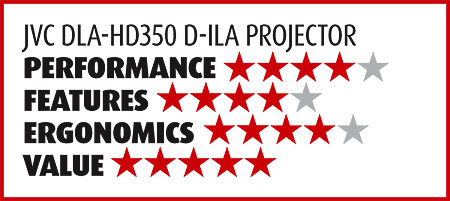JVC DLA-HD350 D-ILA Projector Page 2
The onscreen menus are good, and you can set them to either time out or stay on until you manually close them.

The remote control’s layout is one of the best I’ve seen. The buttons are reasonably large and well spaced, and the backlighting is excellent. You can actually read the function label on each of the buttons. Each of the major video adjustments has its own call-up button. But the remote can be balky in its response. It worked fine for the most part, but sometimes it took its time or even required a repeat command.
Screening
The JVC uses the HQV Reon-VX video-processing solution, so I expected a pristine result. And I got one. Its 480i-to-1080p video processing was uniformly excellent on all but one of my standard video-processing tests. Its one failure was a new test to check for jaggies on 2:2 (video-based source) pulldown. But it passed a second test for this capability without a hitch. Its 1080i-to-1080p processing was similarly superb, with excellent performance across the board.
The projector will produce a perfect 1:1 pixel map. It responds to both above-white and below-black information in the source, but it responds in HDMI only if the HDMI input setting is Enhanced.
There aren’t a lot of gee-whiz features on the JVC, but I did appreciate the Gamma control. Don’t underestimate the importance of getting a video display’s gamma setting right. It controls the light output in the mid-brightness region. A too-low setting can wash out the picture, and a too-high setting can make it too dark and drab—even if the brightness and contrast controls are set correctly.
 All high-end projectors should offer gamma adjustments that are as flexible as the ones on the current JVCs. However, I found that the numbered gammas in the Custom options menu produced a lower gamma than designated. For most program material, I found that the DLA-HD350 worked best with a gamma setting of around 2.2 or just under. And that’s what I got when I set the gamma to 2.0.
All high-end projectors should offer gamma adjustments that are as flexible as the ones on the current JVCs. However, I found that the numbered gammas in the Custom options menu produced a lower gamma than designated. For most program material, I found that the DLA-HD350 worked best with a gamma setting of around 2.2 or just under. And that’s what I got when I set the gamma to 2.0.
I was disappointed by the JVC’s oversaturated colors. Red and green were particular offenders. However, as I noted in the Sanyo review, even wildly oversaturated gamuts such as these aren’t as pumped looking as you might expect on most program material. There’s nothing cartoonish about the JVC’s color. Yes, greens can be a bit plastic looking. And fleshtones, primarily those from a source with colors that are too saturated to begin with (not rare), can look a bit wrong, even pumpkin-like.
But while the overall color shift was often noticeable in a direct comparison against the color-accurate Sony VPL-VW70 (more on this comparison in the Sony review), fleshtone differences were less pronounced. Still, this is a weakness of the JVC (and the Sanyo) that needs to be rectified with either an effective color management system or an accurate out-of-the-box color gamut option.
Beyond that, I had no complaints about the JVC’s picture quality. It was as sharp and detailed as any of the other projectors here on my 78-inch-wide screen. Its resolution (and brightness) remained first rate when I ran it through my simulated, bigger screen test (described in the general introduction to this report).
And of course there were those blacks. While the Sony’s blacks measured better, the JVC more than held its own. It was the best of the three projectors in maintaining punch in an otherwise dark, low-contrast image.
JVC and Sanyo: Head to Head
Both the JVC and the Sanyo had oversaturated color, with the same pros and cons I’ve already mentioned. But the overall color balance between the two was so close that you couldn’t slip a gnat’s hair between them.
The JVC is definitely brighter (with the Normal lamp setting on the JVC and the max lamp brightness on the Sanyo). But on my screen, the differences were subtler than I expected. In compensation, the Sanyo’s Low Dynamic Gamma setting produced a bit more pop in some scenes, though not always. But when I turned off the Sanyo’s Dynamic Gamma, the advantage shifted strongly to the JVC.
The JVC had the higher subjective resolution, but to see it, I had to look intently at the smallest details (textures in faces, walls, etc., or the milling throngs circling the shrine at Mecca in Baraka). Even then, on both the small screen and the large one, the resolution differences were not at all obvious. The JVC’s blacks were clearly deeper (with the Sanyo dynamic iris in Mode 2). And both projectors produced impressive image depth, if present in the program material.
Conclusion
I’m not surprised that the JVC is the value champ in this report. Out of the gate, it was priced at $5,500, but at its current price of $4,500, it’s a knockout. Things are getting very interesting in the projector market, and JVC is in the thick of it. Highly recommended.

- Log in or register to post comments





























































